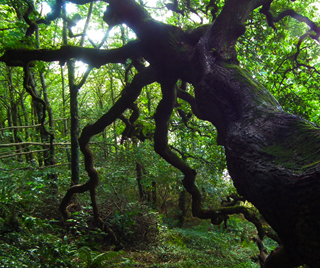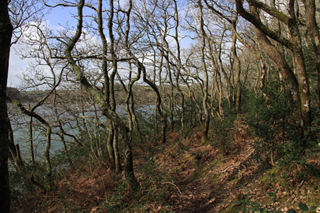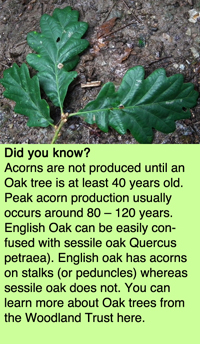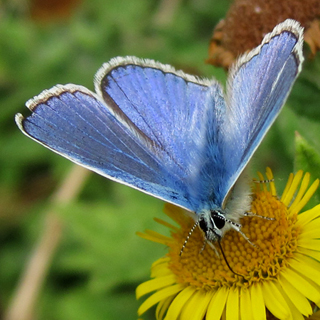A microcosm of life in many forms, the English oak (Quercus Robur) is considered the most valuable tree for biodiversity in the UK. By David Hall

Autumn is here, “season of mists and mellow fruitfulness” as the poet John Keats put it timelessly in 1820. That still stands today as a sign of autumn, just as the huge hidden ancient oak tree in Messack wood stands with branches extending parallel to and almost touching the ground for about 100 feet tip to tip. It must be one of the oldest trees on the Roseland, with a girth of almost 13 feet. It still lives and I would estimate that it is around 200 years old.
Other stands of oak dominate the banks of the Fal on the Roseland side of the Carrick Roads, stretching to the water’s edge on both banks beyond Tolverne: to Philleigh, Ardevora, Sett  Bridge, and then towards Tregony. This is ancient woodland, valuable to UK wildlife in all its forms, flanking the rias through which the Fal flows. The oak and the other deciduous trees which are present – such as beech, ash, sycamore, cherry and chestnut – all lose their leaves in autumn; first producing a startling short but beautiful display of gold, yellow, brown and red.
Bridge, and then towards Tregony. This is ancient woodland, valuable to UK wildlife in all its forms, flanking the rias through which the Fal flows. The oak and the other deciduous trees which are present – such as beech, ash, sycamore, cherry and chestnut – all lose their leaves in autumn; first producing a startling short but beautiful display of gold, yellow, brown and red.
It is thought the main cause is the shortening of daylight hours together with lower temperatures as autumn gathers pace; the reason for the spectacular colours is the change in chemicals within the leaves themselves. Each tree creates an acidic hormone which blocks life to the leaves. Then the dominant green of chlorophyll breaks down and the amazing autumn colours of the other chemicals in the leaves start to appear, until finally they fall from the tree.
 In woodlands, the carpet of valuable leaf litter provides shelter and feeding for ground loving insects, such as stag beetles, wood ants, earthworms, and small animals such as hedgehog. It enables bluebells, primroses and fungi to flourish. The oak is considered the most valuable tree for biodiversity in the UK. Its acorns provide food for squirrels, jays, wood mice, deer, badger and many other wild animals.
In woodlands, the carpet of valuable leaf litter provides shelter and feeding for ground loving insects, such as stag beetles, wood ants, earthworms, and small animals such as hedgehog. It enables bluebells, primroses and fungi to flourish. The oak is considered the most valuable tree for biodiversity in the UK. Its acorns provide food for squirrels, jays, wood mice, deer, badger and many other wild animals.
It is host to hundreds of species of insect and is attractive to many birds as a feeding station. The catkins and leaf buds are loved by purple hairstreak butterflies. The holes in its bark and crevices attract rare dormice, nesting woodpeckers, owls, flycatchers and tits, while several bat species use it for roosting and feeding.
The Oak is our iconic national tree, a symbol of strength and a tree for all seasons.
Upcoming Wild Roseland Walks and talks
Note that all events are free but a small donation of £3 would be welcomed.
Wild Roseland Open Meeting
Tuesday 7th November 2017, 10:00am, Ruan Lanihorne Reading Room.
Our Bi-monthly business meeting (as above). All members welcome to join and take part.
 The Butterflies of Cornwall and their Habitats –
The Butterflies of Cornwall and their Habitats –
A presentation by Shaun Pollard of Wild House Creations.
Accompanied by Roseland National Trust rangers, Phil White and Harriet Davies.
Wednesday 15th November, 7.00pm, Gerrans Memorial Hall.
The Bats of Cornwall,their Conservation and Welfare –
A presentation by Cornwall Bat Group.
Thursday 14th December, 7.00pm. Venue to be confirmed.
Contributors:
David Hall, Sarah Vandome
Edited by Sarah Vandome.
References and links
The Woodland Trust
Wild Roseland
http://www.wildroseland.org/
Enjoy more Roseland wildlife and landscapes – visit Sarah Vandome’s Heart of Roseland Facebook feature:
https://www.facebook.com/HeartOfRoseland?ref=hl
Wild Roseland is on Facebook.
Wild Roseland is a group of volunteers who care passionately about looking after the nature and landscape of the Roseland peninsula in south Cornwall. Through a number of initiatives and projects, the aim is to inspire and enhance the conservation of this special place for all.

